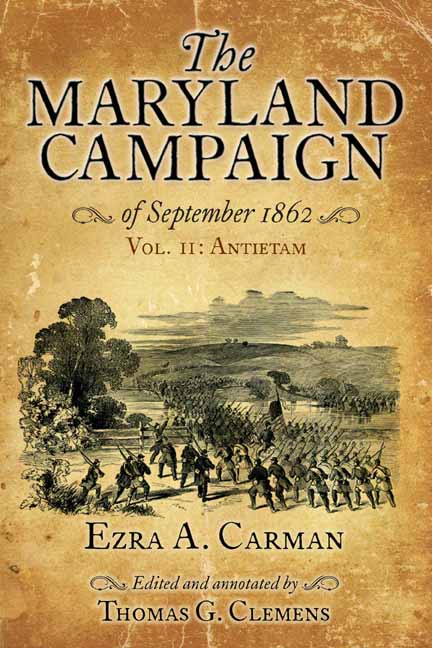The Maryland Campaign of September 1862: Vol. II: Antietam by Ezra A. Carman and edited by Thomas G. Clemens. Savas Beatie, 2012. Cloth, ISBN: 161121114X. $37.50.
 Every serious student of the 1862 Maryland campaign is familiar with Ezra Carman’s classic, path-breaking study, and many historians have cited the manuscript. But it was not until two years ago when Thomas Clemens came out with a heavily annotated edition of the South Mountain portion of the manuscript that both the strengths and limitations of Carman’s work became fully apparently. Now Clemens has issued another superbly edited volume—this one covering Antietam—with a third volume still to come. At last, there will an edition of Carman’s monumental work that will do justice to his great achievement and serve a variety of audiences.
Every serious student of the 1862 Maryland campaign is familiar with Ezra Carman’s classic, path-breaking study, and many historians have cited the manuscript. But it was not until two years ago when Thomas Clemens came out with a heavily annotated edition of the South Mountain portion of the manuscript that both the strengths and limitations of Carman’s work became fully apparently. Now Clemens has issued another superbly edited volume—this one covering Antietam—with a third volume still to come. At last, there will an edition of Carman’s monumental work that will do justice to his great achievement and serve a variety of audiences.
Ezra Carman was both a Civil War veteran and the first serious historian of the Maryland campaign. A Republican, Carman enlisted in the 7th New Jersey Infantry as a lieutenant colonel. Wounded at Yorktown on May 5, 1862, Carman was later appointed colonel of the 13th New Jersey Infantry, and his outfit was in the thick of the fight in Antietam’s famous cornfield. Clemens points out that Carman began gathering material on the campaign almost immediately. More information accumulated after the war as he worked with veterans’ groups and helped locate troop positions at several battlefields. Finally appointed to the Antietam Battlefield Board in 1894, Carman showed enormous dedication even after the funds evaporated. He worked on mapping and marking the battlefield while producing a report that ballooned into a manuscript of some 1800 pages. According to Clemens, Carman was remarkably even-handed in his work. He thoroughly scoured official reports and regimental histories but also gathered a remarkable number of unpublished soldier accounts.
To this day, Carman’s work is the most detailed study of the subject and one well-grounded not only in his own experience but in information gathered from many participants, including some two thousand letters sent to the Antietam Battlefield Board and another thousand or so gathered by 10th Maine Infantry veteran John M. Gould. In his introduction to the text and even more in the voluminous footnotes, Thomas Clemens has set out to discover Carman’s sources and assess the manuscript’s accuracy. He has been able to identity Carman’s sources for a large portion of the manuscript through the most painstaking kind of research and duly notes where he has failed to find a source for various anecdotes or where he can only cite a probable source. His sharp eye catches even small variations between various sources and Carman’s text. Since Carman often lifted passages from his sources almost verbatim without quotations marks or citations and blended a number of sources into a single paragraph, this proved a formidable task.
Carman was, in places, critical of McClellan’s generalship, though Clemens has discovered several inconsistencies in the treatment of McClellan’s strategy and tactics. For their part, historians have generally followed Carman’s lead in their critiques of the disjointed Federal attacks at Antietam. Carman briefly alluded to disappointment with McClellan in the wake of Antietam both in the army and beyond yet does not delve into this important topic very deeply. Carman offered a number of favorable comments about his friend Joseph Hooker but presented a sharply worded appraisal of Ambrose Burnside. Carman sifted through multiple and conflicting sources on a number of points large and small—including the death of General Joseph K. F. Mansfield. Carman’s analysis of Confederate leadership and tactics was fair-minded and shows none of the passion one might expect from a Union veteran. Carman showed great respect for the fighting men on both sides and indeed presented a very idealistic portrait of highly motivated Civil War soldiers. His account of the battle itself was meticulously detailed especially about troop positions and distances between various points on the field. He paid much attention to unit strengths, action at the regimental level, and casualties. Carman carefully dealt with the timing of tactical movements, a task made more difficult by much conflicting information. Carman carefully described landscape features and calculated distances; Clemens offers helpful comments on how the landscape and roads appear today.
All readers will be impressed by all the work and care Clemens took with Carman’s manuscript. In the chapter on the Sunken Road (Bloody Lane) fighting, for instance, there are 106 notes—many of them quite detailed—sorting out all kinds of information. Missing after-action reports and the hazy memories of many veterans—not to mention deliberate omissions and distortions—all made Clemens’s task all that more laborious and difficult. Carman described some of the most complex and confused fighting of the entire war, and Clemens’ annotations document and clarify any number of questions. In this often Sisyphean project, Clemens has succeeded magnificently, and we now eagerly await the appearance of the third volume.
George C. Rable is the Charles G. Summersell Chair in History at the University of Alabama, a former Lincoln Prize recipient, and most recently the author of God’s Almost Chosen Peoples (2010).
